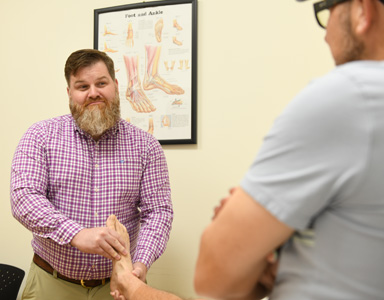Arthritis of Foot and Ankle
![]() Arthritis is the leading cause of disability in the United States. It can occur at any age and means "pain within a joint." As a result, arthritis is often a term used broadly to refer to a number of different conditions.
Arthritis is the leading cause of disability in the United States. It can occur at any age and means "pain within a joint." As a result, arthritis is often a term used broadly to refer to a number of different conditions.
Although there is no cure for arthritis, there are many treatment options available. At Celebration Orthopaedics, we strongly encourage those suffering from arthritis to seek help early so that treatment can begin as soon as possible. Our board-certified podiatrists will prescribe a treatment to help manage pain so you can maintain an active, fulfilling lifestyle.
Symptoms
Arthritis appears at various joints throughout the body, including the hands, feet, hips, spine, and knees, although it is often found in the midfoot and ankle. Patients with osteoarthritis in the foot or ankle usually experience one or more of the following:
- Pain and stiffness in the joint
- Swelling in or near the joint
- Difficulty walking or bending the joint
Some patients with osteoarthritis also develop a bone spur (a bony protrusion) at the affected joint. Shoe pressure may cause pain at the site of a bone spur, and in some cases, blisters. Calluses may also form over its surface. Bone spurs can decrease and limit the movement of the joint.
Causes
Osteoarthritis, also known as degenerative or “wear and tear” arthritis, is a condition characterized by the breakdown and eventual loss of cartilage in one or more joints. As the cartilage deteriorates and gets thinner, the bones lose their protective covering and eventually may rub together, causing pain and inflammation of the joint.
An injury may also lead to osteoarthritis, although it may take months or years after the injury for the condition to develop. For example, osteoarthritis in the big toe is usually caused by kicking, jamming, or by dropping something on the toe. Osteoarthritis in the midfoot may be caused by dropping something on it, or by a sprain or fracture. In the ankle, osteoarthritis is often caused by a fracture and occasionally by a severe sprain.
Sometimes, osteoarthritis develops as a result of abnormal foot mechanics, such as high arches or flat feet. A high arch is rigid and lacks mobility, causing a jamming of joints that increases the risk of arthritis. A flat foot causes less stability in the ligaments (bands of tissue that connect bones), and can result in excessive strain on the joints, leading to arthritis.
Treatment Options
To help relieve symptoms, your Celebration Orthopaedics physician may begin treating osteoarthritis with one or more of the following non-surgical approaches:
- Oral Medications: Nonsteroidal anti-inflammatory drugs (NSAIDs), such as ibuprofen, are often helpful in reducing the inflammation and pain. Occasionally, a prescription for a steroid medication is needed to adequately reduce symptoms.
- Orthotic Devices: Custom orthotic devices (shoe inserts) may be prescribed to provide support to improve the foot’s mechanics or cushioning to help minimize pain.
- Bracing: Bracing, which restricts motion and supports the joint, can reduce pain during walking and help prevent further deformity.
- Immobilization: Protecting the foot from movement by wearing a cast or removable cast-boot may be necessary to allow the inflammation to decrease.
- Steroid Injections: In some cases, steroid injections are applied to the affected joint to deliver anti-inflammatory medication.
- Physical Therapy: Our physical therapists can provide exercises to strengthen the muscles, especially when the osteoarthritis occurs in the ankle. This may give the patient greater stability and help avoid injury that might worsen the condition.
When osteoarthritis has progressed substantially or failed to improve with non-surgical treatment, your physician may recommend surgery. In some advanced cases, surgery may be the only option. The goal is to decrease pain and improve function. Our foot and ankle specialists will consider a number of factors when selecting the procedure best suited to your condition and lifestyle.
